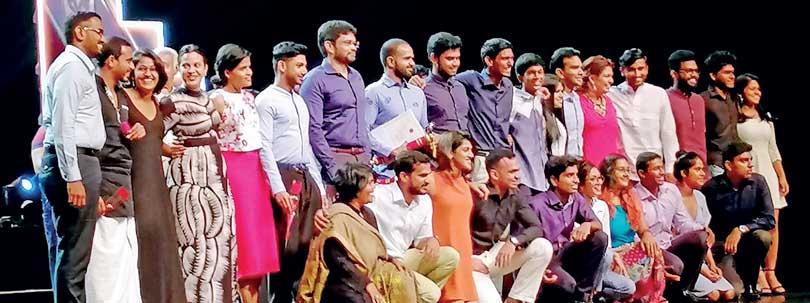02 Apr 2019 - {{hitsCtrl.values.hits}}

 By the time we entered the second half of the Festival, I had a gut feeling who’d win. Sometimes it’s good to trust your instincts. Grease Yaka Returns scooped up seven awards, one after the other, and went on to win the three big statuettes: Best Original Script, Best Direction, and Best Play. Jayampathy Guruge won in four categories: Best Choreography, Best Makeup, and Best Lighting, with a Commendation for Set Design. “It would have been better if he remained up there until everything’s done,” the person next to me remarked. Rather snidely, I should think.
By the time we entered the second half of the Festival, I had a gut feeling who’d win. Sometimes it’s good to trust your instincts. Grease Yaka Returns scooped up seven awards, one after the other, and went on to win the three big statuettes: Best Original Script, Best Direction, and Best Play. Jayampathy Guruge won in four categories: Best Choreography, Best Makeup, and Best Lighting, with a Commendation for Set Design. “It would have been better if he remained up there until everything’s done,” the person next to me remarked. Rather snidely, I should think.
When it first came out some months back, Grease Yaka Returns (GYR) electrified everyone. I remember the guffaws, the barely concealed laughs, and the occasional gasps underlying a curious admixture of shock and awe. It was hard to put a finger on the moods it evoked because there was no real consistency: from one Act to another, and sometimes within the same scene, even the slightest turn of phrase could and did change the direction of the play. The last scene brought the curtains down on shocked audiences; it was hard not to be moved, but at the same time (and for me this was the winning point in the production) we weren’t FORCED to be moved.
GYR plays around with a hackneyed theme so well that it transcends the limits of that theme. Just the other day I saw, at the cinema, an advertisement for a prominent (and mostly lower middle class) cream that asks girls to be “the kind of girly you want to be.” It was hard not to be jolted by the slogan, then smile at the hypocrisy underlying it. The issue, in other words, is one we’re assailed with every day, and everywhere – just what is beauty? – but at the hands of the writers and the actors, it turned out to be something refreshingly different: a brutally sarcastic farce.
Quite a number of Sinhala theatre-goers I know well, hadn’t heard of the play until they saw it at Elphinstone three weeks ago
Two years ago, in a fit or (I guess) paroxysm of enlightenment, I made the following observation: “The Sinhala theatre is focused on open characters that have something to hide, the English theatre is focused on closeted characters that want to get out.” I now realise that such a generalisation is, at best, facile when one tries to review a play like GYR, which as the souvenir itself informs us is a “bilingual play.”
But back then there was a clear rift between English and Sinhala. The two did intrude on each other, but only occasionally so. Today the scene has changed. We no longer take sides between Elphinstone and Lionel Wendt, and we no longer talk about the poverty of the Sinhala playwright and relative affluence of the English playwright. Instead we talk about the (imminent?) rise of an intermediate theatre.
What does this new intermediate/bilingual theatre hold for us? A veritable medley: open characters who want to shut themselves in, closeted characters who want to get out, and secondary players who don’t fit either mould. A play like GYR gives us all the payoffs there because it refuses to stick to the conventional patterns.
It should come as no surprise that most of the cast and crew members in it are involved in other “manifestations” of the bilingual theatre, and that they have been working for a long, long time. Most of them are my age, but the seniors – including the directors, Nishantha de Silva and Rajitha Hettiarachchi – have been at it for a longer time. Many of them hold some sort of degree in theatre, and all of them are clearly, distinctly, uniquely bilingual.
As for their other “manifestations” – we’ve seen the Garage Shows, we’ve seen Pun Intended, we’ve seen Paint Me Perfect (the latter of which, shown last February, I was sadly unable to watch) – while they should not be conflated and should be viewed as independent efforts, the links between those involved in them should at the same time be seen as more than merely a coincidence. Most of them hail from the same milieu (intermediate, like the productions they make and act in) and all of them have been brought together by a passionate devotion to their art which transcends language, ethnicity, and the other divisions which exist in our theatre.
We no longer take sides between Elphinstone and Lionel Wendt, and we no longer talk about the poverty of the Sinhala playwright
They want to take that art forward. The Garage Show in particular, with its defiance of conventional theatre forms, compelled one filmmaker to say that it took him back to the plays of Gamini Haththotuwegama and Parakrama Niriella, and both however, operated not only away from the hall, but from any interiors: they went out there to the streets, put simply. This troupe, on the other hand, is interiorising our theatrical experiences, and inasmuch as I feel the comparison to those two writers wasn’t unwarranted, it’s a facile remark; it generalises what shouldn’t be generalised. But in one thing he was correct: despite the milieus they hail from, both these groups carved and are carving an alternative space for theatre-goers.
If these young playwrights and actors and backstage hands are fuelling a demand for an alternative space, moreover, it’s not because they’ve “manufactured” that demand. Theatre-goers, and I mean here a vast majority of them, are tired of the tropes and the dialogues and the messages that mainstream plays churn out year after year. Even if they’re too polite to admit it straight away, I see the disappointment in their faces, at the middle class desiderata, at the political slogans, at the facilely written dialogues and monologues of protest which the typical playwright conjures up. This has nothing to do with the themes she/he goes for – GYR itself contemplates on an issue that writers have talked about frequently – but rather the way s/he approaches them.
The other contenders at this year’s State Drama Festival, in a way at least, confirmed my suspicions. There was colour, there was pomp, but in the end many of them boiled down to the same topics, and some of them seemed (to put it plainly) too long. Even that otherwise finely done Dario Fo adaptation, The Open Couple, which won for its lead female player an award, seemed overdrawn, as was that other play I thoroughly enjoyed, Chamika Hathlahawatte’s Bombayak Ithuruyi. At a little over an hour, GYR was by contrast short, free of frill and rhetoric, and to the point.
Given this it comes to no surprise that it coveted the attention it got long before its wins at the Festival. But it always astounds me – even depresses me – that quite a number of Sinhala theatre-goers I know well hadn’t heard of the play until they saw it at Elphinstone three weeks ago. There is a widespread assumption, which like all such assumptions is just wrong, that productions like GYR are “English” because they’re made by English speaking artistes. It’s not only that they don’t know this is wrong; it’s also that the idea of a “middle of the road” theatre that defies the distinctions among Sinhala/Tamil and English has eluded them. That is a tragedy, and it ends up limiting works like GYR to what I’d like to call the “theatre-elite.”
It doesn’t have to be limited. The truth is that there’s more in GYR (and the other middle of the road bilingual plays) that speak to audiences across linguistic and ethnic lines than there will be in the typical Sinhala, Tamil, and English only drama. It’s a whole new phenomenon we’re seeing here, and it compels us to question the barriers we’ve drawn up between the shabbily dressed radicals of the young Sinhala theatre and the well dressed bourgeoisie of the young English theatre.
The truth is that there’s more in GYR (and the other middle of the road bilingual plays) that speak to audiences across linguistic and ethnic lines than there will be in the typical Sinhala, Tamil, and English only drama
Many of those who went up there to accept awards, and who belonged to the first category, fitted the stereotypical role of “the deserving artist.” They got an ovation of course, and by projecting that popular stereotypical image of themselves that night they were able to draw a clear line between themselves and the award givers. That sort of conspicuous radicalism hasn’t died out with young Sinhala and Tamil playwrights. They are what the critic Pauline Kael once referred to as “brutalists.” Which is why it seemed to surprise everybody when Grease Yaka Returns scooped up the big statuettes. Here was a play that the radicals and the fawners of the local theatre had missed out. Here was a play that had trumped their popular image of the English theatre as being limited to the air-conditioned proscenium of the Wendt. And here was a play many of them had missed or chosen to ignore at the Elphinstone.The person next to me, on the way out, asked me question after question about the people involved in the production. He was fascinated by what they had done, but he hadn’t seen it. “They should show it again, and again!” he exclaimed. He was shocked that the “preferred giants” didn’t win any of the biggies, but one could see he was also awed. I was awed too, though for the life of me, despite the shouts, the screams, and the smiles, I wasn’t in the least shocked.
The author can be reached on [email protected]
29 Nov 2024 8 hours ago
29 Nov 2024 9 hours ago
29 Nov 2024 29 Nov 2024
29 Nov 2024 29 Nov 2024
29 Nov 2024 29 Nov 2024